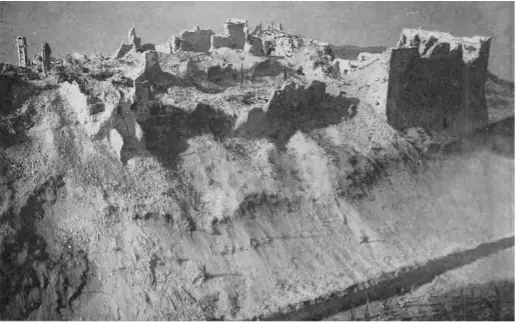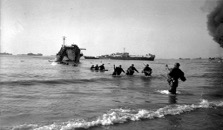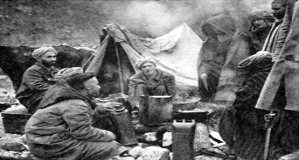AFTER THE FALL
When the fascist regime fell on the 25th of July 1943 many Italian soldiers were left with no orders whatsoever, but all hell became loose on the 8th of September 1943, when the armistice between Italy and the Allies became known to the world thanks to a radio message from General Badoglio.
In the message, read to the nation via radio, he declared that Italy was no longer fighting against the Allies, but it was neither fighting the Germans, in fact, to mark his exact words, he said: “But they may react to possible attacks from any other source”, citing that Italian forces could defend themselves against German attacks. Many soldiers, who weren’t reached by the message, were taken prisoners by the Germans and interned in camps as political prisoners, while others just decided to lay down the arms and return home, some continued to fight for the fascist cause, joining the Italian socialist republic.
GERMAN OCCUPATION
Hitler, to prevent any more problems, decided to enact Operation Axis (Fall Achse in german), occupying Italy with the troops that were already there and also with others that were coming from the Brennero Pass. His orders were to treat Italy as an occupied country, with Kesselring as commanding officer for the central and southern part of Italy. Kesselring decided to create a series of defensive lines, called the Winter lines, with the Gustav Line being the most famous and important (other parts were known as the Hitler Line and the Bernhardt Line). This defensive lines were built by the Germans to counter any allied attack; the Gustav itself barred the way to Rome, and at its center stood the Sanctuary of Monte Cassino, that gave its defenders a clear point of view of any incoming attack.
A battle was fought for the Sanctuary, and it ended with its destruction. Another bloody battle was fought in the town of Ortona, which became known as the “Little Stalingrad”: German paratroopers (Fallschirmjager) commanded by Heidrich fought against Canadian Troops; the battle was won by the Canadian troops but with a high cost of lives.
Fighting around the Bernhardt Line started on the 1st of December 1943 as part of Operation Raincoat, and it ended after months of fighting.

Remnants of Monte Cassino after the battle
ROME FALLS TO THE GERMANS
When Badoglio announced the Armistice via radio, he didn’t expect such a swift reaction from the Germans, who quickly fell down and captured the Italian Capital, poorly defended by the remnants of the Regio Esercito. The King, Badoglio and their staff were forced to flee to Brindisi where they formed the Kingdom of the South and allied themselves with the Allies.
The Germans thought that their Italian counterparts didn’t accept the Allies proposition for the treaty but, upon hearing Badoglio’s speech on the radio, thousands of Germans soldiers were flooding the streets in direction of Rome, with the sole objective of capturing the City before the Allies could intervene and block them. At the time of the announcement, Italian forces numbered 55.000 men and 200 armored vehicles, enough to counter any German offensive in and out of Rome. Unfortunately, lack of coordination between commands, lack of decision-making skills and resolution led to the collapse of these units, who did put up a fight long enough to ensure that the King and his staff could escape to Brindisi. Fighting for Rome continued for 2 more days when, on the afternoon of the 10th a capitulation was obtained by the Germans, who authorized the creation of a command under General Giorgio Calvi di Bergolo. This command didn’t last long, in fact Calvi di Bergolo was arrested on the 23rd by German and RSI forces and then they took command of the city, still keeping its status of “open city”.
THE ALLIES ARRIVE → THE INVASION OF SICILY
It all started with Stalin asking the other allies for the opening of a 2nd front, at first Churchill opted to open one in the black sea, but his idea was discarded, instead they decided to try and invade Italy from the south, calling this “Operation Husky”.
Before the main landings, they had to create a few diverse operations to confuse Axis powers; one was “operation Mincemeat”, which required the use of a dead body strapped with lots of false, sensitive documents. They dumped the body in the neutral waters of Spain and the documents, casually, arrived in the hands of the Abwher, the military intelligence office of Germany.
On this false plans it was written that the Allies were to invade Greece and to use the Sicilian landings as a diversion to confuse the Germans and the Italians. Incredibly, it worked, and Sicilian beaches were left with fewer men than necessary.

Troops land in Sicily
THE MAIN LANDINGS
The first units of paratroopers were launched in the night of the 9-10 of July, and they were preceded by pathfinders who had to mark the landing zones.
Beach landings were made in the early hours of the 10th of July, and were met with serious difficulties because of poor sea conditions. The only thing they expected wrong was the Italian resistance, in fact when they landed the Allies didn’t encounter a single soul, thanks to the fact that the Italian plan didn’t contemplate battle on the beaches.
In some points the Italians managed to make the Americans retreat but were met with gunfire from cruisers and destroyers and had to retreat themselves.
THE FIGHTING FOR THE ISLAND STOPS
Italian and German troops managed to hold some positions and key cities, but were met with clear superiority from the Allies, and after a month of fighting, they decided to retreat to the mainland, with a high cost of materials and men: the Italian Army lost 4600 men, and the Germans were not far behind with 4300, and they had a combination of at least 160.000 captured and/or missing.
INVASION OF THE MAINLAND
Troops under the command of Montgomery landed in Calabria on the 3rd of September during “Operation Baytown”. Other troops landed in Salerno on the 9th during “Operation Avalanche”, and were met with resistance from German troops since the Italians had withdrew from the war the day before. Their objective was to capture and hold the strategic port of Naples, with the city itself being rallied by partisans and anti-fascists movements. The Germans knew that the Allies had something prepared, so they managed to reinforce their lines and even hold them for long, trying and almost succeeding into repelling them from their beachhead, but Allied troops managed to resist and secure a perimeter. At this point, and with the Allies coming more near their positions than what they hoped, the Germans decided to retreat over the Winter lines and hold them as long as possible.
American and English troops managed to enter Naples only on the 1st of October 1943, while the City itself was under a rebellion instigated by Antifascists and the Resistance.
THE ALLIED ADVANCE TOWARDS ROME
With the South of the Peninsula formally secured, Allied troops began marching towards Italy’s capital, Rome, not knowing how long the fight would have lasted.
The Fuhrer himself asked his Kesselring to stop the Allies as much as possible and to create a series of defensive lines (known as Winter lines) to try and stop their advance.
This plan, in part, worked: the American offensive was stopped because of the snow and the bad weather conditions, while the British and Canadian troops had no problem and managed to conquer the lines. It took 4 major offensive for the Allies just to breakthrough the Lines, and Rome was finally captured without encountering any major resistance on the 4th of June 1944.

Allied Troops Enter Rome
THE ANZIO LANDINGS
This battle occurred between January and June, it was intended as a diversion to outflank German Forces near the Winter Line and to directly attack Rome.
The operation itself was intended to be done with the element of surprise, but it all failed because a subordinate of General Clark thought that this action would have had an immediate counter attack, which did not happen. The Germans, instead, managed to re-organize and counter attack, blocking the American for over 5 months. At the end of may there was finally a breakthrough, and the Allies decided to head directly towards Rome instead of helping their comrades in need of help down south at Monte Cassino.

Troops land at Anzio
THE PUSH TOWARDS THE NORTH AND THE GOTHIC LINE
After Rome fell to the Allies, they immediately turned north to try and recapture the remaining parts of Italy occupied by the Germans and the newly founded Italian Socialist Republic.
In August, they pushed forward, taking Florence and coming near the feared Gothic Line.
The Gothic Line was Kesselring’s last major defense line: it was a 320km long line full of machine gun nests, casemates, bunkers, observation posts and artillery positions. The Allies tried for months at capturing these positions, but failed until the decisive breakthrough in April 1945.
In the meantime, the partisans took action and decided to cause problems and distractions to hopefully distract the Germans from sending reinforcements down south.
The final offensive of the Allies started on the 9th of April 1945 with a massive bombardment done by both artillery and bombers. When they finally broke through, armored divisions were sent up to stop the retreating Germans from escaping the city of Bologna, which was freed on the 21st of April.
On the 25th of April, the Committee of Liberation declared a general uprising, meanwhile, units of the Eight US Army advanced towards Venice and Trieste, while the Brazilians were busy marching towards Turin, catching the “Liguria” division by surprise and causing its collapse.
The official surrender of the German garrison of Northern Italy was signed by General Heinrich Von Vietinghoff, successor of Kesselring, on the 29th of April, with all hostilities stopped on the 2nd of May 1945.
WAR CRIMES
AXIS
Studies funded by the German Government found that there were, approximately, 22.000 victims, mostly civilians killed in retaliation for partisans activity and Italian Jews, for the military side, its thought to be 40.000 dead in German captivity. It also excludes the 30.000 partisans who were killed during the war.
Jews
Italian Jews suffered far less persecution in Fascist Italy then their counterparts in Germany, in fact, their situation worsened just after the 1938 Racial Laws, and things obviously got south after the 8th of September 1943, when the Italian authorities provided the Germans with an exact list of all the Jews living in Italy; of the 40.000 that used to live in Italy, historians estimated that as many as 8.000 perished during the Holocaust. The Nazi even created a special unit under SS Obergruppen Fuhrer Karl Wolff, tasked to hunt down and bring the Jews to the concentration camps.
At first, Italian fascists didn’t harm the Jews, but all changed after the Congress of Verona, where they were declared as an “Enemy Nationality” and thus the hunt for Jews began.
Civilians
It’s documented that almost 14.000 civilians, mostly women, children and elderly died by the hands of the Germans, and mostly were killed in retaliation for something else:
-Marzabotto Massacre: 770 civilians killed by the Waffen SS, it’s listed as the deadliest massacre ever recorded in Italian history. It all started as a reprisal for attacks done by Partisans and the Resistance
-Sant’Anna di Stazzema Massacre: 560 civilians were rounded up and killed by the Waffen SS and the Brigate Nere (Black Brigades), as the Marzabotto one, mostly were women and children
-Ardeatine Massacre: 335 civilians and political prisoners killed in Rome on the 24th of March 1944 by German troopers as a retaliation for the Via Rasella Attack against the SS police regiment Bozen the day before. The Germans decided to kill 10 Italians for each dead German, and it was carried out in secret to avoid complications.
ALLIES
Even the Allies were not exempt from making war crimes, the most notable ones are the so called: “Marocchinate”.
This term is used to indicate the mass rape and killing mainly done by Moroccan Goumiers, colonial troops serving under General Alphonse Juin of the French Expeditionary Corps, targeting women and girl in the rural areas of Southern Lazio, Naples and Rome. After the battle of Monte Cassino, it is estimated that nearly 60.000 women, raging from 11 to 86 years old, suffered from violence, and a more recent count set the figure at 3.000 victims. After the war, 207 soldiers weere tried for violence, but 39 were acquitted for lack of evidence.

Moroccan soldiers at Monte Cassino
CONCLUSION
We can clearly say that Italy during, and after the war, has been occupied, sometimes in non violent manners (especially after the war), and sometimes with unfortunate endings (violence, rape, murder etc).
The most brutal occupation was, of course, the German one, which caused almost all the victims, but the Allies are not free from exception.
Since the Italian campaign is mostly overlooked, we can even say that some forget what really happened here, and just brush it off as: “it’s war, it happens”; thankfully in recent years it seems that this issue has, kinda, been resolved and the Italian campaign, and what came after it, has finally been recognized.
